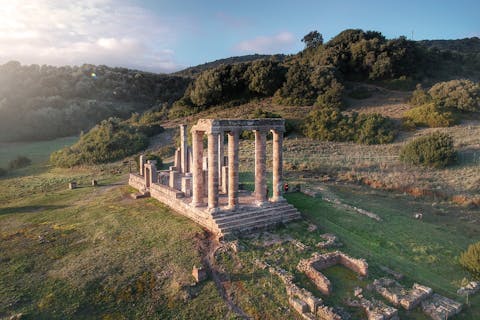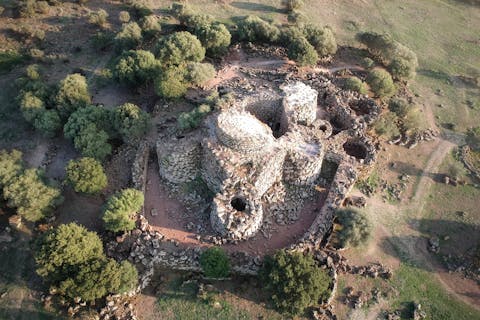Stone, a compass for travel: a talk with Alessandra Cossu and Fabrizio Bibi Pinna | Olianas

People
Stone, a compass for travel: a talk with Alessandra Cossu and Fabrizio Bibi Pinna
by Jessica Cani
They traveled across Sardinia, exploring every corner, clocking up an incredible number of miles to visit nuraghe , sacred wells, domus de janas , castles, country churches, caves, waterfalls, abandoned mines, natural monuments, and much more. They put an enormous amount of time into their studies, even investing money with no small sacrifice. This considerable effort was aimed at improving all aspects of the project, building culture, and raising awareness about the island's history.
We're talking about Fabrizio Bibi Pinna and Alessandra Cossu: together, they watched part of their dream, “La Sardegna oltre al mare” (“Sardinia beyond the sea”), come true and published a photographic book consisting exclusively of the results of their work.
As always, before starting our chat, we were treated to a glass of wine. We asked them what their favorite was, and they suggested a Carignano del Sulcis. Then again, they mused, maybe a Nepente di Oliena or, why not, a Cagnulari. This initial parley about which wine would be best to loosen the tongue (in the end they chose a Carignano) led to a full immersion into one of Sardinia’s most fascinating and mysterious features: its archaeology.

Alessandra Cossu is a professional photographer whose soul is deeply rooted in Sardinia. Her early passion for landscape photography has become a mission aimed at promoting the island and the places where she was born and grew up.
Alessandra strives to encapsulate the spirit of Sardinia in all her shots, portraits and landscape photos alike. “Many tell me that I manage to capture people’s souls, which is beautiful,” she says. “But when they say that about one of my landscape shots, well, that makes me really happy. Because with people, in my opinion, it's easier: people speak to you with their expression, and you can feel their emotions. A landscape, on the other hand, is static. What you perceive is subjective. What I feel is not the same as what someone else will feel in the same place, so if I am told that I have encapsulated the soul of that place, it means that I have taken the energy of that place and truly, authentically experienced the moment.” Capturing the vibrant energy that radiates through places and people on film. These few words might well serve to define her work.
Fabrizio Bibi Pinna stands beside her, both in work and in life. Born into a family that loved spending time outdoors, he grew up near archaeological sites, and there, unknowingly, nurtured his passion while Indiana Jones, his idol at the time, was on TV. “I always say that my passion for archaeology and photography is a kind of Peter Pan syndrome,” he tells us. “When I was a child, my father used to take me around the countryside to collect mushrooms and asparagus. He was never into archaeology, but we would take long drives and often happened to be near archaeological sites. I remember asking him to stop, but he didn't always, and I used to tell my mother that when I grew up I would see them all.”
“My passion stuck, and once I became independent, I started to tour and explore on my own.”

Alessandra always had a vivid passion for archaeology and history. “The first book I was given as a child was about the pyramids. From that very moment, I became obsessed with the Egyptians and Greek and Roman mythology but, unfortunately, during my schooling, no one ever told me about Nuragic history. I started doing research on the Inquisition in Sardinia out of my own interest; that was when I discovered the existence of archaeological sites and was very intrigued. My journey into Nuragic history started this way, but exploded with Fabrizio.”
They met through mutual friends and quickly connected because of their passion. “She wanted to shoot, but no one followed her. I, on the other hand, would shoot alone, even if no one came along,” says Fabrizio. “I remember seeing the first archaeological sites when I was five years old: the Temple of Antas in Fluminimaggiore and the site in Barumini. At the time, the Barumini nuraghe was abandoned, and we used to go inside and play. I’ve always felt the need to explore.”
Thus, in 2017, they decided to chronicle their days spent exploring archaeological sites on social media.

Today, Fabrizio's Instagram profile has 80 thousand followers, and his Facebook page 50 thousand.
There’s a heartfelt mission at the core of what is today called “La Sardegna oltre al mare”: raising public awareness of Sardinia's extraordinary archaeological, natural, and cultural riches, which are yet too little known.
This is not merely a passion for Alessandra and Fabrizio, it is a genuine call to enhance and popularize the island's heritage, for example, by showing how the nuraghi enshrine the vestiges of highly advanced and complex civilizations.
Using breathtaking photographic shots and compelling video narratives, the pair layers experiences and visions to capture the soul of Sardinia beyond marine settings. Alessandra explains: “With the name of this project, we aim to provide insight into this area beyond the extraordinary sea. To us, the coast is kind of like the frame of a painting. It is essential and indispensable, but it’s not the only thing you look at. If you’re looking at a Van Gogh, you don't just stare at the frame. Here, for us, the sea is the enchanting frame of a unique land.”
Their view, however, is not limited to the island's borders. "Sardegna Oltre al Mare" is, in fact, an ever-expanding project that aims to document nuragic-like archaeological sites scattered throughout the Mediterranean and beyond. From the tholoi in Mycenaean Greece to the Torrean vestiges in Corsica, from the rock-cut tombs in Portugal to the symbols of the Mother goddess that can be found virtually everywhere, Alessandra and Fabrizio rediscover millennia-old interconnections that link Sardinia to the rest of the ancient world.
Their mission is borderless and boundless, a journey of knowledge and sharing that unveils the hidden intersections between the people and cultures of yesterday and today. A voyage of research and rediscovery that shapes the deep identity of Sardinia layer by layer.
“When we started, in 2017, no one posted archaeological content. We decided to focus on that, even though, at first, we received very little feedback: we believed in our mission, so we continued. Now, after several years, our project has grown and many people are following us.”

One of the most fascinating aspects of the studies on the Nuragic period relates to the traces of seeds and organic plant remains found inside the nuraghes. Our two experts tell us that the Cagliari Botanical Garden plays a key role in this field by carefully analyzing the findings unearthed during the archaeological excavations carried out throughout the island.
The modern techniques used are bringing to light a wide range of botanical evidence of our ancestors' daily lives. Highlights include the grape seeds unearthed at the nuraghe Arrubiu in Orroli: it’s just 30 km from our winery, so we recommend you include it in your wine tour itinerary when visiting Olianas.
This extraordinary find, the result of a joint effort undertaken by Dutch, French, and Sardinian teams, sheds new light on the earliest origins of viticulture in Sardinia. The excavations in the nuraghes are revealing organic treasures that have been buried for millennia. As Fabrizio and Alessandra tell us, there is also a monumental nuragic village in Gergei that still lies largely buried, guarding who knows what other plant wonders yet to be uncovered.
These botanical discoveries are not mere curiosities, but valuable building blocks that help us reconstruct complex ancient civilizations, all the way from their farming practices to their eating habits.

We end our chat with some culinary advice. When we ask Alessandra and Fabrizio where they like to go for lunch or dinner, they have no doubts: “We’re big fans of picnic lunches at archeological sites: enjoying a sandwich or a homemade fregula salad in one of these spectacular places is an invaluable experience,” says Alessandra. As restaurants go, there are two things they particularly like: pizza and sushi. “For pizza, we go to Maiori. That dough is one of a kind. For the second, we go to Sushi Tao once a month.”
Fabrizio and Alessandra are a striking example of how perseverance and passion can become a profession: exploring and documenting the beauty of Sardinia and sharing their passion with others.

